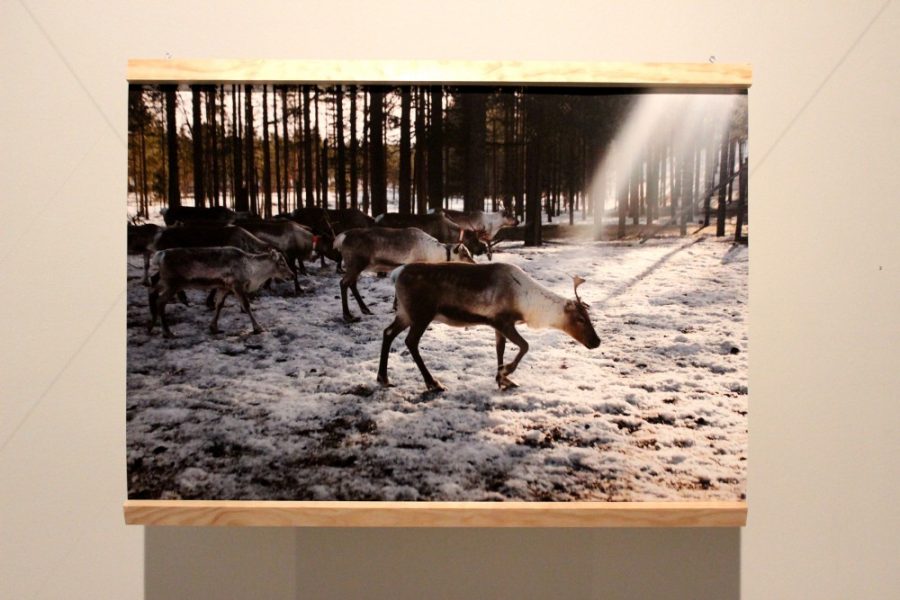Clare Benson, a local artist and UA alumuna, is showing art depicting the ominous “darkness” of the Arctic Circle in her alma mater.
Benson, after graduating from the UA with a Masters of Fine Arts, studied and created artworks for 10 months during the 2014-2015 academic year in northern Scandinavia on an esteemed Fulbright Fellowship.
Benson utilized the Arctic Circle’s landscape to explore the meaning of life on Earth and the complexities of the human condition.
Her multimedia exhibition, which features photographs, videos and writings from her time in Scandinavia, is currently displayed in the School of Art’s Joseph Gross Gallery until Nov. 15.
RELATED: School of Art exhibition translates Snapchat streaks to the physical realm
“While working on the project, I realized its potential to be a longer-term project, and so I applied for an additional grant through the American-Scandinavia Foundation, which allowed me to return to Scandinavia in the spring of 2016 for three months,” Benson said.
While she had a multitude of memorable experiences in Scandinavia, Benson said the Northern Lights were what stood out the most.
“When you are in the far north, [the Northern Lights] cover the entire sky and move in all directions around you,” Benson said. “It is as if you are inside them rather than looking at them from afar.”
Benson said that her initial ideas for the project centered around looking at the sky from the perspective of scientists studying celestial phenomena. This idea is what won her the Fulbright Fellowship, Benson said.
“While living there for almost an entire year, I experienced the extreme shift of light that takes place from summer, a period when the sun does not set, to winter, when the sun does not rise, and so the concept of this shifting light became a bigger and more visceral part of the work.”
Though Benson grew up in northern Michigan where the winters have their own challenges, she said that winter takes on a whole new meaning in the far north.
“There was something ominous about winter there and in the way that people spoke about it,” Benson said. “When many asked how long I would be there, their response to my answer was, with an expression of concern, ‘Oh, so you’ll be here for the darkness.’”
Around October, Benson said that many people start referencing the darkness as a feeling which grows deeper and heavier as the sun slowly disappears from the sky.
“It becomes a part of your psyche and your body in a way that I couldn’t have anticipated,” Benson said. “When the sun returns to the sky, there is a sudden and surprising energy that comes back to your body. It is noticeable in other people as well—the endless light of summer somehow takes on the burden that each of us pulled, like an anchored ship through the darkness of winter.”
Benson said the elements of the sky and light during these different periods served as the most challenging and rewarding aspects of her journey.
RELATED: UA Poetry Center series discusses climate change, one poem at a time
Along with this vivid landscape, Benson was given the opportunity to work with scientists and space physicists specializing in unique fields.
“It was an incredible honor and also quite humbling to be working alongside scientists whose research is so rich and intricate,” Benson said.
The experience has had an immense effect on Benson’s self and artistic endeavors.
“I found it particularly difficult to go from working among a community of artists to a community of scientists, though being in that space offered continuous inspiration, and the two worlds of science and art have a large amount of overlap,” Benson said. “[The experience allowed] my work to branch out in new directions, which helps me maintain a certain level of awe, respect and patience for my creative process.”
Benson said she notices darkness affects her personality because it slows her down.
Being surrounded by others going through the same ordeal helped her acclimate to the climate—just going for a midday walk would offer “a feeling of hope and a reminder that the sun was still out there.”
Benson said she is proud to have her work exhibited at the UA. Her collection is a unique experience for observers, and she believes its elements will continue to appear in her future projects.
“It is an incredible opportunity to be able to share the work with my mentors and the people who helped guide me through my time as a graduate student,” Benson said.
Benson currently works as a visiting faculty artist at Arizona State University. Check out her exhibition at the Joseph Gross Gallery Monday through Friday, 8 a.m. to 4 p.m. through Nov. 15.
Follow Brianna Darling on Twitter









